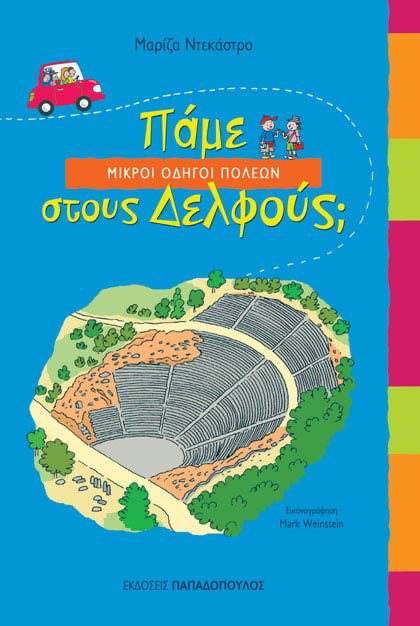Title of the work
Country of the First Edition
Country/countries of popularity
Original Language
First Edition Date
First Edition Details
Μαρίζα Ντεκάστρο [Marisa De Castro], Πάμε στους Δελφούς; [Páme stous Delfoús?] (Short City Guides [Μικροί Οδηγοί Πόλεων (Mikroí Odīgoí Póleōn)]), ill. Mark Weinstein. Athens: Papadopoulos Publishing, 2009, 32 pp.
ISBN
Genre
Guidebook
Illustrated works
Instructional and educational works
Picture books
Target Audience
Children (target reader: 6+)
Cover

Courtesy of the Publisher. Retrieved from epbooks.gr (accessed: July 5, 2022).
Author of the Entry:
Katerina Volioti, University of Roehampton, Katerina.Volioti@roehampton.ac.uk
Peer-reviewer of the Entry:
Susan Deacy, University of Roehampton, s.deacy@roehampton.ac.uk
Elzbieta Olechowska, University of Warsaw, elzbieta.olechowska@gmail.com

Marisa De Castro
, b. 1953
(Author)
Marisa De Castro was born in Athens and was educated at the Sorbonne, Paris. De Castro, who has worked as a primary-school teacher, has written a large number of children’s books, mostly about art history and archaeology.
Sources:
Profile at the epbooks.gr (accessed: July 3, 2018).
Profile at the metaixmio.gr (accessed: July 3, 2018).
Bio prepared by Katerina Volioti, University of Roehampton, Katerina.Volioti@roehampton.ac.uk

Mark Weinstein (Illustrator)
Mark Weinstein is an American writer and illustrator who has been living in Greece since 1997.
Source:
Profile at the EP Books website (accessed: April 17, 2018).
Bio prepared by Katerina Volioti, University of Roehampton, Katerina.Volioti@roehampton.ac.uk
Summary
As we read on the opening page, here we have a guide to Delphi in central Greece, "one of the most sacred locations for the ancient Greeks" (my translation). Mythology, archaeology and art history feature prominently in this booklet, accounting for the site’s significance.
Analysis
Despite its small size, the book is particularly rich, informative and could also interest adult readers. Delphi is a very complex archaeological site, and this booklet helps all visitors.
A sketch map of southern Greece shows Delphi and other towns or places of interest. For Thebes, De Castro and Weinstein give us background information and a small sketch drawing of Oedipus and the sphinx, perhaps preparing us for the colossal statue of the Sphinx from Naxos in the Archaeological Museum of Delphi at the end of the book. De Castro continues with scene-setting by presenting a bird’s eye view of the road to Delphi below Parnassos and the Phaidriades.
Mythology is needed to explain Delphi further. The Omphalos marks the centre of the world, where Zeus’ eagles met. In fleeing Apollo’s pursuit, Daphne became a Laurel tree. According to ancient Greek belief, we are told, the gods had turned some people into trees (in Daphne’s case, her father, the river god Peneus transformed her to protect her from Apollo), plants, and flowers.
Background information about Apollo is presented in a humorous manner. Firstly, we have Apollo’s police-like identity card, with his genealogy, multiple epithets, favourite musical instruments, weapons, plants, and animals. Secondly, we read about Leto’s and Apollo’s journey to Delphi and the slaying of the Python. The mythological narrative is recounted succinctly.
The following pages expand on divination and what it means for mortals. The Greeks and international visitors to Delphi appear to have found it hard to determine the god’s will. Themistokles was smart, realising that the “wooden walls” referred to ships. De Castro explains the step-by-step process of receiving prophesies, and the fun illustrations here help enormously to visualise the different steps. In the end, however, we read that we cannot ascertain how Pythia came up with prophecies.
Children learn about archaeological excavations and the re-discovery of Delphi in recent times. No mention is made of the substantial involvement of French archaeologists. Yet, the illustration showing an archaeologist unearthing a male statue takes cues from real events, specifically the excavation of a statue of Antinoos by the Temple of Apollo in 1893*. Indeed, the head of this statue is shown at the end of the book. De Castro’s presentation of the “archaeological site” is simple and easy to follow. The main buildings, such as the Temple of Apollo and the Siphnian Treasury, are marked, and we are reminded that what we see today is a mosaic of remains from different periods. A focus on the theatre and the stadium are most welcome, as these are major landmarks and potentially familiar to children from other sites in Greece. There is a brief reference to mythology for the stadium, as Zeus started the Pythian Games to honour Python.
Having wandered around the site (and the landscape), children enter the Archaeological Museum of Delphi. In the museum, statues speak. Thus, Kleobis and Biton, two iconic images of Archaic art, tell their story, which is partly mythological and factual. Children pick up some general knowledge too, as the statues clarify what kouroi and korai stand for. The Charioteer’s self-introduction includes information about materials and craftsmanship, prompting children to look closely at the statue’s surface. The Sphinx from Naxos explains her monstrosity, and how she is a mixture of a woman, bird, lion, and eagle. She defines herself as a “mythical creature”. By contrast, Antinoos refers to Hadrian's historical figure: "I am Antinoos, the favourite friend of Roman Emperor Hadrian" (my translation).
Children are asked to observe details of famous museum exhibits. De Castro and Weinstein are to be praised for making children look at artefacts of different materials (metal, clay, stone), think about the objects’ function (e.g., a hydria for water), and learn about mythology (e.g., a golden plaque showing the Gorgon).
The last page, showing the family car, informs us about places of interest near Delphi, including a Byzantine monastery which is yet another place of historical significance.
* See historicaltimes.tumblr.com (accessed: August 3, 2018).
Further Reading
Information about the book at epbooks.gr (accessed: August 3, 2018).


